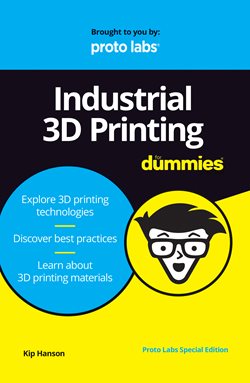Read Industrial 3D Printing for Dummies
Latest News
May 23, 2017
Here’s a fun diversion: Google “for dummies books.” You’ll unearth a zillion titles. Some will confound you, while others will amuse or intrigue. Today’s Check it Out link takes you to a “for dummies” e-book that’s sure to interest designers, machinists, manufacturers and the intellectually curious.
No matter your 3D printing knowledge, you’ll find Industrial 3D Printing for Dummies engaging and informative. The author, a fellow named Kip Hanson, deserves kudos. His breezy, witty writing reels you in while conveying potentially complex information clearly and succinctly.
 Industrial 3D Printing for Dummies provides an evenhanded explanation of all aspects of 3D printing from technologies to materials and design considerations. Image courtesy of John Wiley & Sons Inc. and Proto Labs Inc.
Industrial 3D Printing for Dummies provides an evenhanded explanation of all aspects of 3D printing from technologies to materials and design considerations. Image courtesy of John Wiley & Sons Inc. and Proto Labs Inc.This e-book is tagged as a Proto Labs special edition, a relationship to your benefit. See, as an on-demand manufacturing bureau, Proto Labs provides injection molding, milling and turning as well as 3D printing services. Consequently, this isn’t a hagiography. It states unequivocally that 3D printing is a part of the design and manufacturing toolset. An invaluable part, for sure. But not always your best or sole option. Refreshing.
The eight chapters in this e-book cover everything from the history of 3D printing to current and emerging technologies to materials and design tips. Each chapter is self-contained, so you can easily read your area of interest out of sync. Don’t ignore that history chapter. It’s actually quite fascinating.
Chapter 3 is where to go if you’re looking to slice through the minutia and get to the core relevance of 3D technologies. It has a handy table of the pros and cons of major technologies like FDM, SL, SLS, PolyJet and DMLS. And, yes, the acronyms are explained, and brief 101-level tutorials outline how the technologies operate.
Chapters 4 and 5 cover plastic and metal materials, respectively. Outstanding work here. You aren’t forced to slog through specs that’ll tickle a metallurgist fancy. But you are offered a broad array of details on where different materials – say, nylon or cobalt chrome – are best used.
The penultimate chapter looks at designing for 3D printing. It abounds with tips, tricks and heads-ups on everything that’s different about CAD for 3D printing. Even grizzled veterans will pick up a few pointers.
The last chapter covers everything important that preceded it, only in 10-point form. It’s a good place to start for slow readers short on time.
But don’t skip the rest of it. Even if you think you know the drill, Industrial 3D Printing for Dummies will learn you something. Hit today’s Check it Out link and get your copy.
Thanks, Pal. – Lockwood
Anthony J. Lockwood
Editor at Large, DE
Subscribe to our FREE magazine, FREE email newsletters or both!
Latest News
About the Author
Anthony J. Lockwood is Digital Engineering’s founding editor. He is now retired. Contact him via [email protected].
Follow DE







